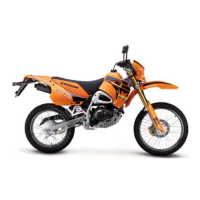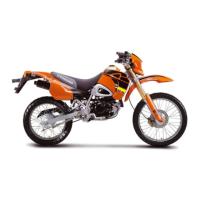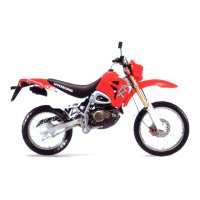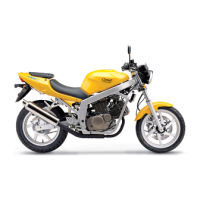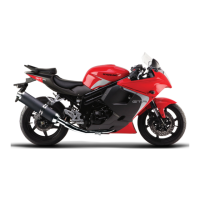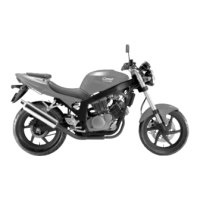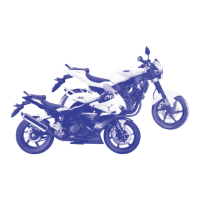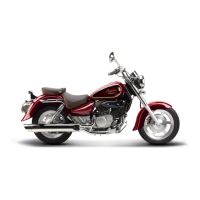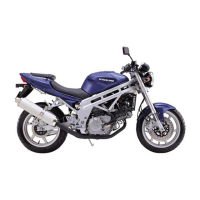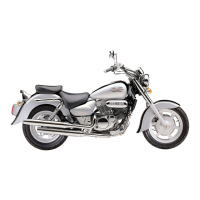Do you have a question about the HYOSUNG RT125D and is the answer not in the manual?
Explains the meaning of signal words like WARNING, CAUTION, and NOTE.
Provides precautions for safe motorcycle riding and operation.
Emphasizes wearing a helmet and eye protection for safety.
Advises on choosing comfortable and safe riding apparel.
Encourages practicing to become familiar with the motorcycle's controls.
Details the type of unleaded gasoline to use.
Specifies the grade and type of engine oil recommended.
Explains the function and positions of the ignition switch.
Details the motorcycle's ignition keys and their identification number.
Describes the motorcycle's instrument panel indicators and displays.
Explains the function of switches located on the left handlebar.
Explains the function of switches located on the right handlebar.
Describes how engine speed is controlled via the throttle grip.
Details the operation of the motorcycle's light switch.
Explains how to use the starter switch to start the engine.
Describes the function and use of the choke lever for cold starts.
Explains the operation and positions of the fuel cock.
Details the operation of the rear brake pedal.
Explains how to shift gears using the gearshift lever.
Describes the operation and safety features of the side stand.
Explains how to separate and assemble the seat.
Details how to adjust the rear suspension spring pre-load.
Provides instructions on how to refuel the motorcycle safely.
Explains how to check the engine oil level and capacity.
Provides instructions for starting the engine, considering cold and warm conditions.
Offers safety advice and procedures for starting to ride the motorcycle.
Explains how to use the transmission for optimal operation and safety.
Provides guidance on riding the motorcycle on uphill and downhill slopes.
Details the correct procedure for stopping and parking the motorcycle.
Recommends throttle opening limits during the initial break-in period.
Warns against maintaining a constant low speed during break-in.
Advises on varying engine speed for proper break-in of engine components.
Guides on how to break in new tires for maximum performance and safety.
Emphasizes allowing engine oil to circulate before applying load.
Highlights the importance of the initial 1,000km service for the motorcycle.
Identifies key points requiring lubrication for smooth operation and longevity.
Lists the tools supplied with the motorcycle for maintenance.
Details checks for the front fork for proper operation and assembly.
Guides on inspecting the rear shock absorber for oil leakage and spring condition.
Explains maintenance-free battery inspection and care.
Provides steps for cleaning battery terminals and reconnecting the battery.
Explains how to clean and maintain the air cleaner element.
Describes how to clean and adjust the spark plug gap.
Covers carburetor adjustments for idling speed and throttle cable play.
Explains how to adjust the throttle cable play for proper engine response.
Guides on adjusting the clutch cable play for proper clutch operation.
Covers inspection, adjustment, cleaning, and oiling of the drive chain.
Discusses checking brake fluid level and inspecting brake pads.
Details how to inspect front brake pads for wear and replacement.
Guides on checking the brake disk for damage or cracks.
Explains how to replenish brake fluid in the front brake master cylinder.
Describes the location and adjustment of the front brake lamp switch.
Covers rear brake adjustment and lining wear limit checks.
Explains how to check brake shoe wear using indicators on the rear brakes.
Details the location and adjustment of the rear brake lamp switch.
Explains the importance of correct tire pressure for handling and safety.
Guides on checking tires for visible cracks, cuts, or foreign materials.
Details how to inspect tire tread depth using wear indicators.
Advises on inspecting the rear axle shaft and jointing nut for loosening.
Explains how to inspect spoke nipples for looseness and retighten them.
Details the procedure for replacing the motorcycle's headlamp bulb.
Explains how to replace the turn signal lamp bulb.
Provides instructions for replacing the brake and tail lamp bulbs.
Explains the location of the fuse box and how to check fuses.
Outlines troubleshooting steps for engine starting issues.
Guides on how to wash the motorcycle properly.
Advises on post-cleaning inspection and lubrication.
Lists the motorcycle's physical dimensions and dry mass.
Details the engine type, bore, stroke, and displacement.
Provides details on the clutch, final reduction, and gear ratios.
Lists specifications for suspension, steering, tires, and brakes.
Details specifications for ignition, battery, fuses, and lamps.
Lists the capacities for fuel tank and engine oil.
Explains the meaning of signal words like WARNING, CAUTION, and NOTE.
Provides precautions for safe motorcycle riding and operation.
Emphasizes wearing a helmet and eye protection for safety.
Advises on choosing comfortable and safe riding apparel.
Encourages practicing to become familiar with the motorcycle's controls.
Details the type of unleaded gasoline to use.
Specifies the grade and type of engine oil recommended.
Explains the function and positions of the ignition switch.
Details the motorcycle's ignition keys and their identification number.
Describes the motorcycle's instrument panel indicators and displays.
Explains the function of switches located on the left handlebar.
Explains the function of switches located on the right handlebar.
Describes how engine speed is controlled via the throttle grip.
Details the operation of the motorcycle's light switch.
Explains how to use the starter switch to start the engine.
Describes the function and use of the choke lever for cold starts.
Explains the operation and positions of the fuel cock.
Details the operation of the rear brake pedal.
Explains how to shift gears using the gearshift lever.
Describes the operation and safety features of the side stand.
Explains how to separate and assemble the seat.
Details how to adjust the rear suspension spring pre-load.
Provides instructions on how to refuel the motorcycle safely.
Explains how to check the engine oil level and capacity.
Provides instructions for starting the engine, considering cold and warm conditions.
Offers safety advice and procedures for starting to ride the motorcycle.
Explains how to use the transmission for optimal operation and safety.
Provides guidance on riding the motorcycle on uphill and downhill slopes.
Details the correct procedure for stopping and parking the motorcycle.
Recommends throttle opening limits during the initial break-in period.
Warns against maintaining a constant low speed during break-in.
Advises on varying engine speed for proper break-in of engine components.
Guides on how to break in new tires for maximum performance and safety.
Emphasizes allowing engine oil to circulate before applying load.
Highlights the importance of the initial 1,000km service for the motorcycle.
Identifies key points requiring lubrication for smooth operation and longevity.
Lists the tools supplied with the motorcycle for maintenance.
Details checks for the front fork for proper operation and assembly.
Guides on inspecting the rear shock absorber for oil leakage and spring condition.
Explains maintenance-free battery inspection and care.
Provides steps for cleaning battery terminals and reconnecting the battery.
Explains how to clean and maintain the air cleaner element.
Describes how to clean and adjust the spark plug gap.
Covers carburetor adjustments for idling speed and throttle cable play.
Explains how to adjust the throttle cable play for proper engine response.
Guides on adjusting the clutch cable play for proper clutch operation.
Covers inspection, adjustment, cleaning, and oiling of the drive chain.
Discusses checking brake fluid level and inspecting brake pads.
Details how to inspect front brake pads for wear and replacement.
Guides on checking the brake disk for damage or cracks.
Explains how to replenish brake fluid in the front brake master cylinder.
Describes the location and adjustment of the front brake lamp switch.
Covers rear brake adjustment and lining wear limit checks.
Explains how to check brake shoe wear using indicators on the rear brakes.
Details the location and adjustment of the rear brake lamp switch.
Explains the importance of correct tire pressure for handling and safety.
Guides on checking tires for visible cracks, cuts, or foreign materials.
Details how to inspect tire tread depth using wear indicators.
Advises on inspecting the rear axle shaft and jointing nut for loosening.
Explains how to inspect spoke nipples for looseness and retighten them.
Details the procedure for replacing the motorcycle's headlamp bulb.
Explains how to replace the turn signal lamp bulb.
Provides instructions for replacing the brake and tail lamp bulbs.
Explains the location of the fuse box and how to check fuses.
Outlines troubleshooting steps for engine starting issues.
Guides on how to wash the motorcycle properly.
Advises on post-cleaning inspection and lubrication.
Lists the motorcycle's physical dimensions and dry mass.
Details the engine type, bore, stroke, and displacement.
Provides details on the clutch, final reduction, and gear ratios.
Lists specifications for suspension, steering, tires, and brakes.
Details specifications for ignition, battery, fuses, and lamps.
Lists the capacities for fuel tank and engine oil.
| Power | 11.5 hp |
|---|---|
| Max Power RPM | 8500 rpm |
| Fuel System | Carburetor |
| Transmission | 5-Speed |
| Front Suspension | Telescopic Fork |
| Rear Brake | Drum |
| Seat Height | 780 mm |
| Engine Type | Single Cylinder, 4-Stroke |
| Displacement | 124 cm³ |
| Cooling System | Air |
| Front Brake | Disc |
| Fuel Tank Capacity | 12.5 L |

